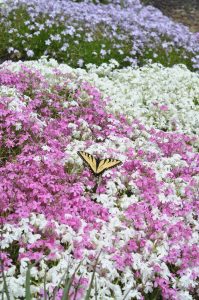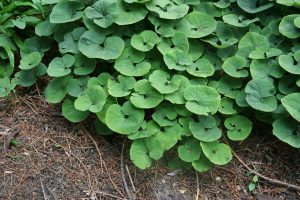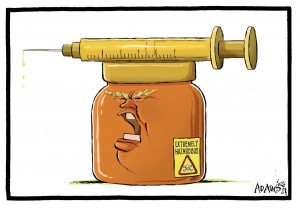Apparently, the president believes that ultraviolet light, shone on one’s skin or, through some miracle of engineering, on one’s innards, will cure COVID-19. I, on the other hand, am pretty sure the only thing significant exposure to UV rays will do is give me skin cancer. Between an assiduous practice of social distancing and the damp of a cloudy April, I’m not fearing either the disease or Trump’s cure for it. Sheltering at home, however, makes me grateful that my home includes ample outdoor space.
Space that shows some evidence of inattention.
The Ravages of Time
As a gully carved into the slope deepens with each rain, I search for strategies to secure the hillside. Most of the strategies have failed. Heaps of mulch have been washed away and rivers of white stone are buried in silt. Roots of trees and shrubs are exposed where I hoped they would hold the soil.
Ultimately, I think the answer lies in ground cover.
Last year I renewed my dedication to creeping phlox. The older plants produce clouds of white, pinks and pale blues in the spring—and each year the clouds are more cumulus. April is definitely our moment of curb appeal. Our combination of clay soil studded with rocks, shade, and alternation patches of soggy soil and arid dirt are unwelcoming to many plants I have found. Ferns are not the easy success I had hoped for although the first fronds of the spring are more promising than before. What I really need is some kind of attractive foliage that will embrace the earth and thrive and not look like a salad bar to the deer.
The Right Plant in the Right Place
As I drank my tea and read through the morning papers, an item in the gardening section of The Baltimore Sun caught my eye. “Golden Groundsel.”
Golden groundsel, wrote someone on behalf of the University of Maryland Extension Service, checks off many of the attributes Marylanders are looking for in a native plant — or any plant. Deer don’t eat it. ‘Packera aurea’ grows in sun to shade. Golden yellow flowers rise in spring on stems 1-2 feet above the heart-shaped foliage, blooming over a long period and attracting butterflies. It prefers moderate to moist soil.
Be still my beating heart! That is my exact checklist! A groundcover that is deer resistant and goes from sun to shade. It also has a bloom that attracts butterflies? An embarrassment of riches. Almost by accident I found the last containers of Senecio aureus (aka Packera aurea) at The Perennial Farm, the place I go to spend money I don’t have. I picked the dozen best looking of the scrawny lot; we will see how they do in different locations.
Six containers of Asarum canadense (wild ginger) await me in Pennsylvania at Redbud Native Plant Nursery. It’s not as showy as the groundsel but it claims similar virtues. According to the Perennial Farm catalog:
Our native ginger has kidney-shaped leaves on 4-6” tall stems that form a colony in the woodland or moist shade garden. Unless you are camping out and place your sleeping bag next to a colony of wild ginger, you will probably not notice the ground-hugging blooming ‘brown jugs’ underneath the foliage. A must for the woodland garden with Tiarella, Native Ferns and creeping Phlox.
Tried and True
Meanwhile I will continue filling up spaces with plants proven to be perennial in this weird ecosystem of mine. A little more Veronica penduncularis “Georgia Blue” which has gotten comfortable in three different areas. More hellebore absolutely. My hellebore are spectacular this year. Of course buying randomly means that I have a striking variety of petal color and shape and leaf pattern. Not that I can name any of the cultivars.
Hope springs eternal so I have indulged in a few iris cristata and, yes, a new variety of fern, Athyrium otophorum (Limelight Lady Fern). I quote the catalog again: The new foliage of this fern emerges lime green with reddish-pink stems and midribs. Mature foliage is darker green and the combination of old and new is quite attractive in containers or the mixed shady border. Sounds lovely if, Mother Nature willing, it grows.
Preservation and Restoration
Is this the year that erosion on my hillside is slowed, even halted and reversed? I don’t know. I don’t know either if the efforts of the GOP to slow the erosion of support for Trump among conservatives by reducing his airtime at COVID-19 briefings will work. Nor do I expect the erosion of faith in American institutions and the rule of law will be stemmed if good defeats evil in November. Both the president and the cascades of water down my slope are damaging whatever lies in their paths.





